
Deposition Date
2013-11-20
Release Date
2014-09-24
Last Version Date
2023-12-06
Entry Detail
PDB ID:
4NP7
Keywords:
Title:
Structure of phosphotriesterase mutant (S308L/Y309A) from Agrobacterium radiobacter with diethyl thiophosphate bound in the active site
Biological Source:
Source Organism:
Agrobacterium tumefaciens (Taxon ID: 358)
Host Organism:
Method Details:
Experimental Method:
Resolution:
1.99 Å
R-Value Free:
0.25
R-Value Work:
0.20
R-Value Observed:
0.20
Space Group:
P 31 2 1


